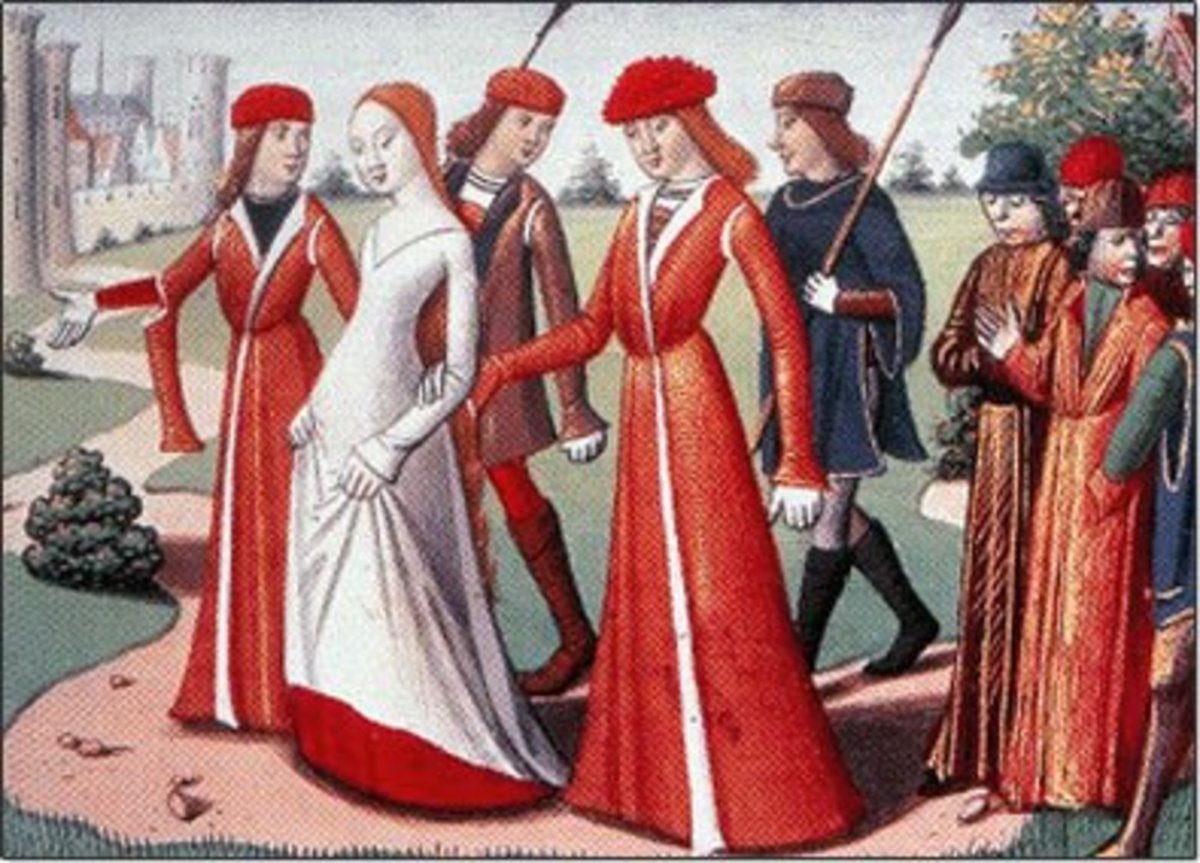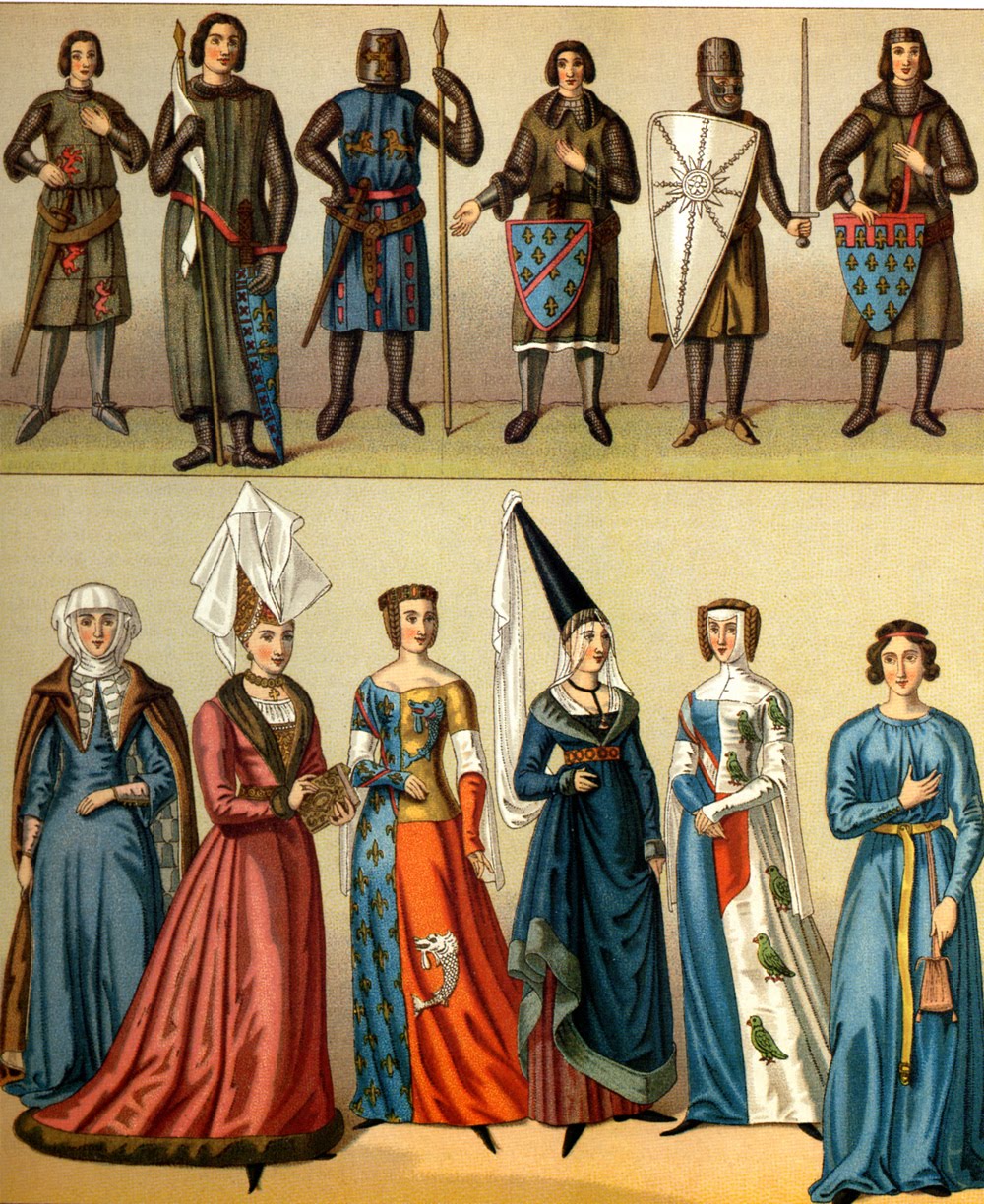
DeviantArt More Artists Like 1872 Trouville in spring by AprilMo Medieval clothing, Medieval
In the Middle Ages, clothing was integral to identifying one's place in the world. Medieval people were highly skilled at reading the meaning of fashion, which is reflected throughout the painted pages of illuminated manuscripts. In Philosophy Presenting the Seven Liberal Arts to Boethius, female personifications of philosophy and the seven.

Modehistoria från hög och senmedeltiden medeltida kläder Teal Sound
For Rich and For Poor. Although they lived centuries before the Middle Ages, biblical figures were often represented in contemporary medieval dress to fit into the fashion of the time, such as in this scene of Christ's crucifixion. The Piercing of Christ's Side, Simon Bening, about 1525-1530, From the collection of: The J. Paul Getty Museum.

12th century bliaut, medieval dress in wool, linen and silk, by Prior Attire Medieval clothing
Wealthy women and noblewomen wore tunics, or sleeveless dresses that came to the floor, just as peasant women did, but the material choice was very different. The wealthy preferred more colorful, luxe fabrics and rich embroidery. Fur was usually worn on the inside of clothes to keep women warm, but as the era wore on, fur trim became more popular.

Historical Fiction Resources Fashion in the Early Middle Ages
A look inside Eleanor de Montfort's wardrobe, and why it was important for a 13th-century countess to dress extravagantly and beautifully. People in the Middle Ages liked to layer up. Including underwear and outerwear, an everyday outfit regularly consisted of at least six different garments. There were three main pieces: a tunic, surcoat.

Middle Age Dresses The Dress Shop
Pearson's Renaissance Shoppe is your source for beautiful Medieval Dresses and Renaissance Dresses. Spanning the Dark Ages to the times of Pirates ruling the seven seas, our Renaissance costumes for women are authentic and comfortable. But we shouldn't get caught up with just medieval knight armor or pirate wench costumes - even.

Pin on Medieval Fashions
The typical women's clothing for the fifth and sixth centuries was a body-length garment pulled up to the armpit and worn over a sleeved under-garment, usually another dress, by fastening brooches at the shoulders.. A kirtle is a type of garment that was commonly worn by women in the Middle Ages. It typically consisted of a bodice and a.

The Medieval Clotheshorse Roger Wieck on the Fashion Revolution of the Middle Ages Getty Iris
In the late fourteenth century the external corset came into fashion. Although women's gowns were fastened in front up to the throat in the early medieval period, by the latter end of the period necklaces encircled the now bared neckline. Dresses also became full around the hips using padded rolls. The clothing of women in the lower ranks of.

How Did People Make Fabric in the middle ages and How Did They Color It. Middle ages clothing
Information on medieval clothing for costumers. Peasant Clothing. Peasant men wore stockings or tunics, while women wore long gowns with sleeveless tunics and wimples to cover their hair. Sheepskin cloaks and woolen hats and mittens were worn in winter for protection from the cold and rain. Leather boots were covered with wooden patens to keep.

Renaissance style short cloak with hood. Shipping worldwide! Renaissance fashion, Medieval
Article. As in just about any other period of history, clothing in the Middle Ages was worn for necessity, comfort, and display. Bright colours and rich decorations made for a striking medieval wardrobe, at least among the wealthy, although there was a surprising similarity in clothes for different social classes and the sexes.

Middle ages women's clothing Medieval clothing women, Clothes for women, Middle aged women
Women's Clothing in the Middle Ages. In the fascinating world of the Middle Ages, medieval fashion played a significant role in defining the social status and identity of women. The clothing of medieval women was influenced by various factors, including their social status, occupation, and the prevailing fashion trends of the time.. Introduction to Medieval Fashion

Beautiful Isabella of France, queen of England on Middle Ages.. Middle ages dress, Middle ages
In the early Middle Ages, clothing was typically simple and, particularly in the case of lower-class peoples, served only basic utilitarian functions such as modesty and protection from the elements.. The normal women's costume of this era was a long peplos-like garment, pulled up to the armpit and worn over a sleeved undergarment (usually.

Pin auf MODA MEDIEVAL
Women's Clothing Layers. For women in medieval times, clothing layers were also an important aspect of their attire. Similar to men, women would start with a linen or cotton chemise as their base layer.. During the Middle Ages, women would commonly dress in multiple layers of garments, such as hose, a chemise as an underdress, and a tunic.

Queens Regent Isabeau of Bavaria History of Royal Women Middle ages clothing, Middle age
In the Middle Ages, ladies wore multiple layers of clothing, including a hose, a long underdress called a chemise, and a tunic or kirtle over the chemise. Noble women's dresses were made from fine.

14th Century Archives Page 2 of 11 World4 14th century clothing, Medieval clothing
the Middle Ages? Norse Man and Woman by Johannes Gehrts, 1884. Viking age men and women used tweezers, combs, and ear scoops for… erm, scooping out earwax. Ahem. Another trend that the modern metrosexual man may embrace, while a more macho modern man often eschews, is coloring the hair. In our

Middle Ages fashion history in Germany. in 2020 Middle age fashion, Fashion history, Medieval
Women's Clothing. Women's clothing consisted of an undertunic called a chemise, chainse or smock. This was usually made of linen. Over the chemise, women wore one or more ankle-to-floor length tunics (also called gowns or kirtles). Working class women wore ankle-length tunics belted at the waist. Women of the French court wore a loosely.

Medieval dress/Fantasy costume/Middle age fairy dress by ElaVintageHandmade on Etsy https//www
Women's clothing during the Middle Ages featured a variety of patterns and embellishments that added visual interest to their attire. Embroidery was a popular technique used to decorate garments, with intricate designs often depicting scenes from religious texts or nature. Additionally, fabrics were adorned with woven patterns such as stripes.